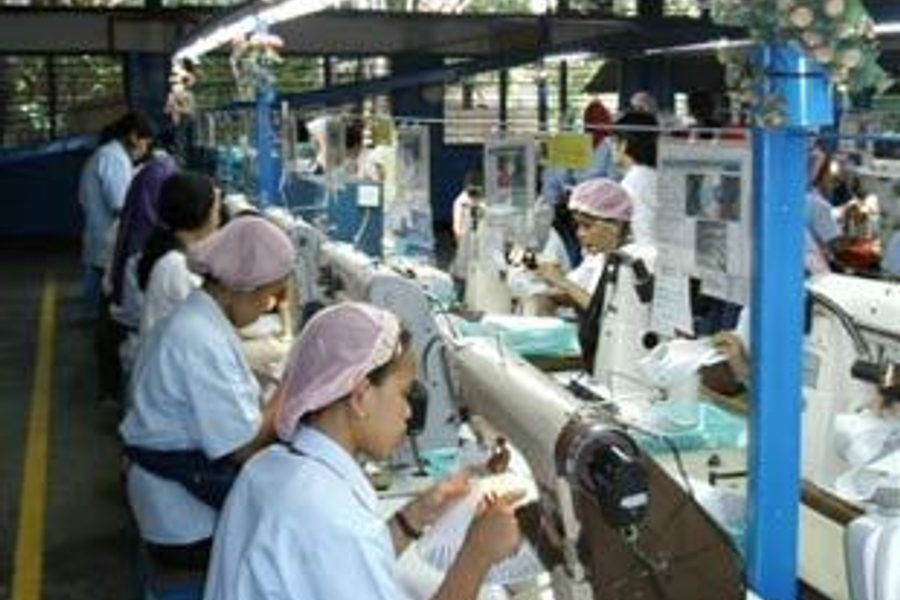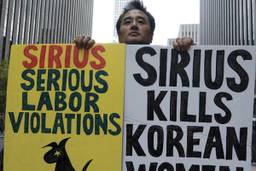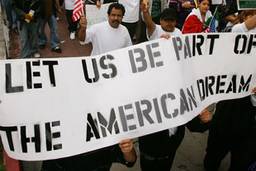Students vs. Sweatshops, Round III
The Designated Supplier Program targets college clothing companies
Mischa Gaus

Claudia Ebel is traveling across Thailand this summer, but her itinerary is no vacation. The University of Colorado at Boulder sophomore is meeting with sweatshop workers, promoting a plan to change how college clothes are made – and the lives of the people who make them.
This summer, United Students Against Sweatshops (USAS) is sending 14 students like Ebel to 12 countries. The trips will prepare college anti-sweatshop activists for a busy year, as they try to convince universities to write sweeping new demands into the multimillion-dollar contracts they sign. The new rules will strip companies licensed to make college-logo apparel of their exclusive control over prices and decisions about where clothes are made. To stay in the lucrative collegiate game, apparel corporations will have to produce increasing percentages of collegiate garments in factories where workers are represented and receive steady work for living wages.
Thirty universities have signed up for the Designated Supplier Program, or DSP, as the new rules are called, since the program’s kick-off last September. The list includes large, revenue-heavy schools like Duke University and the entire University of California system, giving the program heft as students and universities iron out the details this summer in preparation for a fall rollout.
Ebel has plenty of work to do. Although some unions and NGOs in countries with struggling apparel industries have released statements supporting the supplier program, which grew out of their conversations with USAS, others have trepidation. According to Somsak Praiyoowong of the Thai Center for Labor Rights, Thai garment workers don’t trust apparel companies, because the brands’ public allegiance to previous efforts reining in the industry hasn’t meant much.
“It is obvious that brands move production around as they see fit without any regards to workers,” Praiyoowong says.
— — — — — — —
The source of the sweatshop movement’s power has long been the big contracts that colleges ink with apparel companies, a market estimated between $3 and $4 billion per year. By using those contracts to achieve leverage over the prices corporations pay to their subcontracted factories – and requiring decent wages and long-term relationships – anti-sweatshop advocates aim to foster the spread of high-road development in poor countries.
Robert Pollin, an economics professor at the University of Massachusetts at Amherst, argues that consumers could see price increases of 1 to 6 percent as a result of mandating living wages for garment workers, if brands choose to pass the costs along. That loose change extracted from college alums equals doubled wages in many sweatshops.
These tough new contract provisions are the third wave of college sweatshop activism in the last decade. First, students won codes of conduct that declare the principles under which college clothing should be sewn – among them, respect for freedom of association and dignified working conditions. Six years ago, USAS helped found an independent monitoring group, the Worker Rights Consortium, to respond to sweatshop workers’ complaints.
Making those principles stick in factories produced notable achievements, including the recognition of independent unions in countries where such organization was previously unthinkable. But the efforts were limited to about 20 factories at which the Consortium devoted significant energy to ending abuses like sexual harassment, blacklisting of employees attempting to organize and theft of severance pay by managers.
Enforcing the code when violations arose proved a weak approach to confronting the entrenched practices of the apparel industry. Most of the thousands of factories making collegiate apparel didn’t face the scrutiny of a Consortium investigation, and the ones that did – and made improvements – sputtered.
“The only way for a factory to survive in today’s apparel marketplace is to function as a sweatshop – holding production costs down by abusing worker rights,” says Scott Nova, the Consortium’s executive director. “Although the factory is certainly responsible for their actions, it is primarily the fault of the brands and retailers who set the prices that make the market.”
The prices brand-name corporations pay to factories for their clothing have dropped consistently because they demand lower costs and shift production rapidly around the globe to find them. According to Jill Esbenshade, a sociology professor at San Diego State University and sweatshop researcher, factory prices for cotton T-shirts over the last decade fell by more than half in Honduras and almost a third in Mexico.
Trade rules exacerbated this dynamic when the Multi-Fiber Agreement quota scheme expired last January, allowing companies to move huge amounts of clothing production to countries with abysmal labor conditions like China and Vietnam.
In this fearful climate, factories pushed into respecting worker rights were penalized by brands, which pulled their orders. A Dominican cap factory that was an early test case for the Consortium went from winning a collective bargaining agreement that boosted wages to massive layoffs as brands sought marginally lower prices elsewhere.
The brands’ refusal to stand by factories making improvements, Nova says, sends the unmistakable signal that improving working conditions is an invitation to unemployment.
“It seems if the fish cannot be killed,” says Gilberto Garcia of the Center for Labor Support and Education in El Salvador via a translator, “they want to suffocate it by taking away the water.”
— — — — — — —
No factory could meet the new DSP standards today, mostly because no garment workers receive living wages.
The program would cut the number of factories producing collegiate clothes to a small pool that either already meet the standards or agree to meet them, and to promise to open up to scrutiny to ensure the attempt is sincere. More factories would join as the requirement to purchase clothes from high-road suppliers increases from 25 percent the first year to 75 percent the third. After the third year, universities would have the choice to bring their entire apparel production into the program.
“With so many workers impacted, these things take time,” says Tim Hillman, a USAS representative to the program’s implementation group and a civil engineering Ph.D. candidate at the University of Colorado at Boulder. “Nobody can say what the conditions should be for the workers except the workers themselves.”
USAS dispatched students like Ebel to meet with worker groups and unions, explain the program and get their feedback.
Apparel brands grumble that the supplier program hasn’t paid enough attention to technical issues, like ensuring sufficient specialization. Universities note that if brands are unhappy, they can bring their favored factories into the program, provided they meet the standards.
“You’ve got to have a system that allows the volume, quality, variety and delivery,” says LaMarr Billups, a special assistant to the chancellor at the University of Wisconsin at Madison and a member of the supplier program’s implementation team. “It’s a larger issue than we’ve faced in recent years, but it’s not something we won’t be able to overcome.”
Brands also trot out old arguments against a living wage, saying it is too complex and difficult to arrive at in each of the many countries where apparel is produced. “You could ask five experts what the living wage is for a country and you’re going to come up with five different answers,” says Gregg Nebel, director of social and environmental affairs for Adidas and a board member of the Fair Labor Association (FLA), the other major sweatshop-monitoring group.
To address this, the supplier program would not set wage levels but would respond when workers complain to the WRC that factory management isn’t offering livable wages during negotiations. A committee of local groups and industry experts would produce a baseline from a local basket of goods. Brands would be instructed to offer better prices to the factory for its garments if the current prices aren’t high enough to allow the factory to pay its workers decent wages.
The Consortium has already tested the exercise twice, assessing the local baskets of goods that would produce the living wage baseline in El Salvador and Indonesia. However, as Nova asks, “What food items we’ve referred to are too generous for a family in Indonesia? Which clothing items in El Salvador do [apparel companies] feel a family doesn’t need or shouldn’t have a right to? They make the same rhetorical statements they’ve made for a decade to avoid being held accountable for the wages that the people who sew their clothing are being paid. It’s an enormous moral cop-out.”
A major concern is how to include sweatshops in China and Vietnam, which essentially outlaw labor unions. Although difficult, worker representation isn’t impossible in those countries, anti-sweatshop advocates say, because local officials defer to factory management.
Hong Kong NGOs are already holding labor-rights trainings in factories on the mainland, and quietly identifying those where worker committees with negotiating powers could be established. The current draft of the supplier plan allows those shops onto the list of factories producing collegiate wear.
— — — — — — —
The supplier program has split the college antisweatshop world, with USAS and the Consortium backing it and the FLA standing at a frigid distance. The FLA has several apparel corporations on its board of directors, and has been accused by USAS of standing pat several times while its own corporate members dithered during a factory crisis. Bill Clinton was integral in establishing the FLA as a response to the 1996 Kathie Lee Gifford scandal. But while it soothed the public mood at the time, a decade later industry-led oversight has changed very little.
Nova wrote a letter to the FLA in March protesting “numerous inaccuracies” in the FLA’s public statements about the supplier program, while USAS launched a Web site, FLAWatch.org, to showcase “the true agenda of this ‘fox guarding the hen house.’ “
“The FLA’s intent is to show some of the issues surrounding the DSP and engage on all sides to find some consensus,” Nebel says. “I see an unsavory confrontation that takes energy away from the work we’re trying to do, which is make improvements in the supply chain.” He says Adidas and the FLA prefer a “management systems” approach to improving sweatshop conditions, which consists of training factory managers in identifying inefficiencies in their plant and establishing consistent corporate hierarchies and policies.
Efficiency and trainings are fine, anti-sweatshop activists say, but without a structure like the DSP to ensure that workers are represented in the factory and guaranteed decent wages, there’s little chance efficiency gains would reach them. They suggest another reason the perpetually tense relationship among the sweatshop monitors is fraying: the corporations guiding the FLA realize the new rules will make business as usual impossible.








